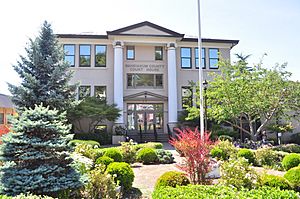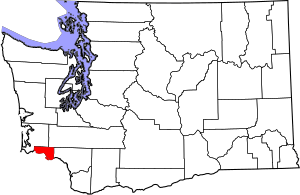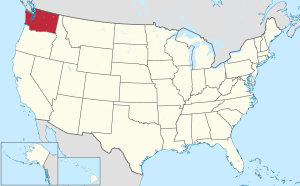Wahkiakum County, Washington facts for kids
Quick facts for kids
Wahkiakum County
|
|
|---|---|

Wahkiakum County Courthouse in Cathlamet
|
|

Location within the U.S. state of Washington
|
|
 Washington's location within the U.S. |
|
| Country | |
| State | |
| Founded | April 24, 1854 |
| Named for | Chief Wahkiakum |
| Seat | Cathlamet |
| Largest town | Puget Island |
| Area | |
| • Total | 287 sq mi (740 km2) |
| • Land | 263 sq mi (680 km2) |
| • Water | 24 sq mi (60 km2) 8.3%% |
| Population
(2020)
|
|
| • Total | 4,422 |
| • Estimate
(2023)
|
4,765 |
| • Density | 15/sq mi (6/km2) |
| Time zone | UTC−8 (Pacific) |
| • Summer (DST) | UTC−7 (PDT) |
| Congressional district | 3rd |
Wahkiakum County is a county in the state of Washington. In 2020, about 4,422 people lived here. This makes it one of the smallest counties in Washington by population.
The main town and county seat is Cathlamet. The county was created in April 1854 from Cowlitz County. It is named after Chief Wahkiakum, a leader of the Chinook people. His name means "Tall Timber". Chief Wahkiakum is buried in Cathlamet.
The county runs the Wahkiakum County Ferry. This ferry connects Cathlamet to Westport, Oregon. It crosses the Columbia River.
Contents
History of Wahkiakum County
The land that is now Wahkiakum County was once home to the Wahkiakums. They were a group of Chinookan peoples. Scientists have found old tools and signs of fishing and hunting near Skamokawa. These findings show people lived there about 2,300 years ago.
Early Explorers and Settlers
In 1792, an American sea captain named Robert Gray explored the Columbia River. He was the first known American to visit this area. In the early 1800s, the Hudson's Bay Company had a station here. They salted salmon at Fort George.
The first trading post was set up near Skamokawa in 1844. Later, in 1846, James Birnie opened another trading post called Birnie's Retreat. His wife, Charlotte Beaulieu Birnie, helped protect Cathlamet during a conflict called the Puget Sound War.
Wahkiakum County was officially created in 1854. Cathlamet became its county seat.
New Arrivals and Industries
Early settlers came from Great Britain and the eastern United States. Around 1870, many people from Sweden, Norway, Finland, and Dalmatia arrived. From 1870 to the early 1900s, many Chinese residents also lived here. They worked in the fish canneries.
In 1912, the county's total population was 5,283. In the early days, there were no roads. People traveled between communities by walking or by boat. Later, as roads were built, some smaller towns disappeared.
Main Jobs and Businesses
People in Wahkiakum County worked in fishing, logging, farming, and trading. Salmon canning started in 1866. Many canneries quickly opened. Chinese workers were brought in to help in 1872. Over time, too much fishing and changes to the rivers hurt the salmon. The last salmon canning in Wahkiakum County was in 1947.
The county had many trees, so logging was a big business. Logs were moved by water. Later, loggers used oxen and then trains. The first logging train started in 1892.
Many immigrants cut down trees to clear land for farms. By 1912, there were about 140 farms. Most of these were dairy farms. The first cooperative creamery on the west coast opened in Skamokawa in 1898. A farming group called the National Grange of the Order of Patrons of Husbandry started a local chapter in 1901.
The first newspapers in the area included the Cathlamet Gazette (1889) and the Skamokawa Eagle (1891). The Skamokawa Eagle is still the county's official newspaper today.
Geography of Wahkiakum County
Wahkiakum County covers about 287 square miles. About 263 square miles are land, and 24 square miles (8.3%) are water. It is the smallest county in Washington by total area. It is the third smallest by land area.
Important Rivers and Islands
- Columbia River: A major river forming the county's southern border.
- Elochoman River: A river flowing through the county.
- Grays River: Another river in the county.
- Puget Island: A large island in the Columbia River, part of the county.
Main Roads
Neighboring Counties
- Pacific County – to the northwest
- Lewis County – to the north and northeast
- Cowlitz County – to the east and southeast
- Columbia County, Oregon – to the south and southeast
- Clatsop County, Oregon – to the south and southwest
Protected Natural Areas
- Julia Butler Hansen National Wildlife Refuge (part of it is in the county)
People of Wahkiakum County
| Historical population | |||
|---|---|---|---|
| Census | Pop. | %± | |
| 1860 | 42 | — | |
| 1870 | 270 | 542.9% | |
| 1880 | 1,598 | 491.9% | |
| 1890 | 2,526 | 58.1% | |
| 1900 | 2,819 | 11.6% | |
| 1910 | 3,285 | 16.5% | |
| 1920 | 3,472 | 5.7% | |
| 1930 | 3,862 | 11.2% | |
| 1940 | 4,286 | 11.0% | |
| 1950 | 3,835 | −10.5% | |
| 1960 | 3,426 | −10.7% | |
| 1970 | 3,592 | 4.8% | |
| 1980 | 3,832 | 6.7% | |
| 1990 | 3,327 | −13.2% | |
| 2000 | 3,824 | 14.9% | |
| 2010 | 3,978 | 4.0% | |
| 2020 | 4,422 | 11.2% | |
| 2023 (est.) | 4,765 | 19.8% | |
| U.S. Decennial Census 1790–1960 1900–1990 1990–2000 2010–2020 |
|||
Wahkiakum County has one of the smallest populations in Washington state. Its population of 4,422 is very small compared to Washington's largest county, King County.
Population Details from 2010
In 2010, there were 3,978 people living in the county. There were 1,737 households, which are groups of people living together. About 1,187 of these were families. The county had about 15 people per square mile.
Most people (94.0%) were white. Other groups included American Indian (1.3%), Asian (0.6%), and Black (0.3%). About 2.7% of the people were of Hispanic or Latino background. Many people had family roots from Norway (19.8%), Germany (19.3%), or England (13.3%).
About 21.9% of households had children under 18. The average household had 2.26 people. The average family had 2.69 people. The average age of people in the county was 52.3 years old.
The average income for a household was $40,372. For a family, it was $47,266. About 12.2% of all people lived below the poverty line. This included 14.5% of those under 18.
Towns and Communities
Main Town
- Cathlamet (This is the county seat, where the county government is located.)
Other Communities
These are places where people live, but they are not officially towns:
- Altoona
- Deep River
- East Cathlamet
- Grays River
- Lower Elochoman
- Puget Island
- Rosburg
- Skamokawa Valley
- Upper Elochoman
Smaller Unincorporated Communities
- Brookfield
- Eagle Cliff
- Flandersville
- Skamokawa
- Waterford
Famous People from Wahkiakum County
- Krist Novoselic: He was the bass player for the famous grunge band Nirvana.
- Robert Michael Pyle: A scientist who studies butterflies and moths, and also an author.
- Hadley Caliman: A talented jazz musician.
Images for kids
See also
 In Spanish: Condado de Wahkiakum para niños
In Spanish: Condado de Wahkiakum para niños


